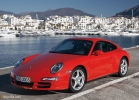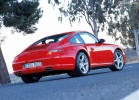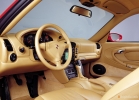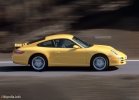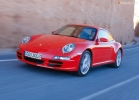Test drive Porsche 911 Carrera 997 2004 - 2008 coupe
Lightning for you
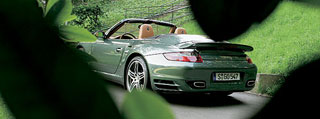 Porsche dignifiedly celebrated the 20th anniversary of the release of its first convertible Turbo Cabriolet series. The third generation of the car has been released by this date, and to describe the stages of development of the series, it is enough to bring several digits. The first generation had an engine with a capacity of 300 liters. p., capable of dispersing the car to 100 km/h in 5.4 seconds. The second generation, released in 2003, was equipped with an engine with a capacity of 420 liters. p., and acceleration to hundreds took 4.3 seconds. And finally, the third generation. 3.6 liter engine and with a capacity of 480 liters. With. It accelerates the convertible to 100 km/h in 3.8 seconds, and the maximum speed is 310 km/h.
Porsche dignifiedly celebrated the 20th anniversary of the release of its first convertible Turbo Cabriolet series. The third generation of the car has been released by this date, and to describe the stages of development of the series, it is enough to bring several digits. The first generation had an engine with a capacity of 300 liters. p., capable of dispersing the car to 100 km/h in 5.4 seconds. The second generation, released in 2003, was equipped with an engine with a capacity of 420 liters. p., and acceleration to hundreds took 4.3 seconds. And finally, the third generation. 3.6 liter engine and with a capacity of 480 liters. With. It accelerates the convertible to 100 km/h in 3.8 seconds, and the maximum speed is 310 km/h.  With the third-generation Porsche 911 Turbo Cabriolet, we met on a test drive in the vicinity of Frankfurt. A dozen cars of various configurations were waiting for us near the hotel. The design is absolutely recognizable, one might say, conservative (for Porsche 911 Turbo). The same familiar (and thus dear to us) features: almost round headlights (bixenon) with a large angle of inclination, aggressive gills of air intakes in front of the rear wheeled arches, an anger and muscular body. The developers did not reflect a radical change in the design of the mass of the innovations that this car gained. With the help of representatives of the manufacturer, we begin to get acquainted with these innovations and very soon we get tired of their transfer one. Let us dwell on the main ones.
With the third-generation Porsche 911 Turbo Cabriolet, we met on a test drive in the vicinity of Frankfurt. A dozen cars of various configurations were waiting for us near the hotel. The design is absolutely recognizable, one might say, conservative (for Porsche 911 Turbo). The same familiar (and thus dear to us) features: almost round headlights (bixenon) with a large angle of inclination, aggressive gills of air intakes in front of the rear wheeled arches, an anger and muscular body. The developers did not reflect a radical change in the design of the mass of the innovations that this car gained. With the help of representatives of the manufacturer, we begin to get acquainted with these innovations and very soon we get tired of their transfer one. Let us dwell on the main ones. The convertible engine for the first time received a double turbocharger with a variable geometry of turbines. This made it possible to achieve such impressive indicators of dynamics. The machine is literally stuffed with a variety of smart systems that help to humble the power of the engine if necessary and direct it in the right direction (literally). This is a full -wheel drive system with electronic Porsche Traction Management, which allows to smoothly redistribute the torque between the front and rear wheels, and the active control system for the stiffness of Porsche Active Suspension shock absorbers
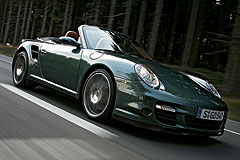 Management, and the Porsche Stability Management stabilization system, and something else there. All this filling, along with passengers, can be closed (or open) using a three -layer tent, which, together with glass with heating and drive mechanism, weighs only 42 kilograms, and opens/closes in 20 seconds. It is possible to produce this beautiful manipulation, including lowering glasses, including the rear, to a speed of 50 km/h. If desired, you can additionally order a removable hard top - Hardtop.
Management, and the Porsche Stability Management stabilization system, and something else there. All this filling, along with passengers, can be closed (or open) using a three -layer tent, which, together with glass with heating and drive mechanism, weighs only 42 kilograms, and opens/closes in 20 seconds. It is possible to produce this beautiful manipulation, including lowering glasses, including the rear, to a speed of 50 km/h. If desired, you can additionally order a removable hard top - Hardtop. The basic configuration involves a mechanical six -speed gearbox, but you can get an automatic five -speed TipTronic S box to order. The fact that with an automatic box the car accelerates to 100 km/h is 0.2 seconds faster than with a mechanical one, although it consumes at This is more fuel (13.7 liters against 12.9 liters per 100 km). Ceramic brake discs and Sport Chrono Turbo package are also registered options, including not only the stopwatch and more sports settings of all systems, but also the Overboost button, which allows briefly increase the pressure of turbocharged and thereby acceleration.
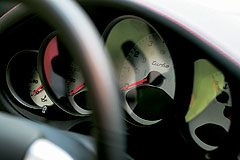 Having finished with the study of the material and technical part, we proceed to practical driving. From the very first kilometers, the car surprises its suitability for ordinary urban driving. It allows you to move without stalling and not polishing the asphalt with tires (the latter, however, is closely monitored by the anitrop -consuming system). The car is only a sufficiently tight clutch pedal and the need to handle the gas pedal is very delicate. Some insufficiency of the view through the rear window with a margin is compensated by the side mirrors (by the way, with automatic darkening). All controls are located in the usual places and are easily achievable. The addictions will only require the numerous buttons to control the multimedia center located around the display, including the navigation module, and by order - the phone. The sound of this center is very worthy, which is quite natural, because it is provided by a seven -rock digital amplifier and 12 Bose speakers.
Having finished with the study of the material and technical part, we proceed to practical driving. From the very first kilometers, the car surprises its suitability for ordinary urban driving. It allows you to move without stalling and not polishing the asphalt with tires (the latter, however, is closely monitored by the anitrop -consuming system). The car is only a sufficiently tight clutch pedal and the need to handle the gas pedal is very delicate. Some insufficiency of the view through the rear window with a margin is compensated by the side mirrors (by the way, with automatic darkening). All controls are located in the usual places and are easily achievable. The addictions will only require the numerous buttons to control the multimedia center located around the display, including the navigation module, and by order - the phone. The sound of this center is very worthy, which is quite natural, because it is provided by a seven -rock digital amplifier and 12 Bose speakers. 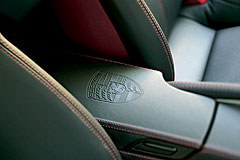 We finally leave the city and get to the highway, where, after the sign, all restrictions are the end and fall into the native element of this machine. The car is literally transformed after an energetic press on the gas pedal. All the horse dozing for the time being wake up and, as if adjusted to the miserable animal exhausted by the formidable animal exhaust, drive a light car directly to the horizon. Close and utilitarian goals are no longer considered. The anti -wing rises 120 km/h, which can be seen in the side mirrors. It seems that the examination of the work of the anti -wing is the main purpose of mirrors at the maximum permissible speeds of this convertible: hardly anyone will catch up and will be alarm by headlights. We were convinced that the manufacturers did not deceive at maximum speed. Acceleration ended when the speedometer showed 320 km/h. We slow down to fifty, fold the roof and repeat acceleration. A new surprise awaits us here, and even two: firstly, it is possible to accelerate to the same speed with an open top and not scary, and secondly, at the same speed (the speed of a small screw aircraft), passengers can still talk or listen to music-though , with increased volume. It seems that manufacturers have seriously worked with the machine in an aerodynamic pipe: the noise of the wind at an open roof increases smoothly to a speed of 120-150 km/h, and then remains at about one, quite tolerant level.
We finally leave the city and get to the highway, where, after the sign, all restrictions are the end and fall into the native element of this machine. The car is literally transformed after an energetic press on the gas pedal. All the horse dozing for the time being wake up and, as if adjusted to the miserable animal exhausted by the formidable animal exhaust, drive a light car directly to the horizon. Close and utilitarian goals are no longer considered. The anti -wing rises 120 km/h, which can be seen in the side mirrors. It seems that the examination of the work of the anti -wing is the main purpose of mirrors at the maximum permissible speeds of this convertible: hardly anyone will catch up and will be alarm by headlights. We were convinced that the manufacturers did not deceive at maximum speed. Acceleration ended when the speedometer showed 320 km/h. We slow down to fifty, fold the roof and repeat acceleration. A new surprise awaits us here, and even two: firstly, it is possible to accelerate to the same speed with an open top and not scary, and secondly, at the same speed (the speed of a small screw aircraft), passengers can still talk or listen to music-though , with increased volume. It seems that manufacturers have seriously worked with the machine in an aerodynamic pipe: the noise of the wind at an open roof increases smoothly to a speed of 120-150 km/h, and then remains at about one, quite tolerant level. 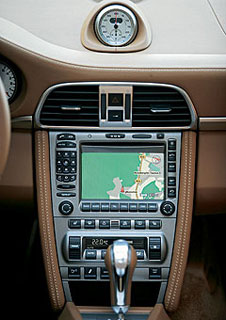 The behavior of the machine is so flawless that a powerful motor provokes an aggressive ride: we try turns with excess speed and/or engine thrust. Here, various smart systems begin to intervene in management. Moreover, they do this with a certain mocking tact: first they allow you to start skidding, and after a split second it will be eliminated, leaving the driver the feeling that he himself did so easily and professionally coped with the situation.
The behavior of the machine is so flawless that a powerful motor provokes an aggressive ride: we try turns with excess speed and/or engine thrust. Here, various smart systems begin to intervene in management. Moreover, they do this with a certain mocking tact: first they allow you to start skidding, and after a split second it will be eliminated, leaving the driver the feeling that he himself did so easily and professionally coped with the situation. We transplant to a car with an automatic box and get a lot of new very pleasant sensations: not only can you forget about switching, but the machine performs them so accurately and correctly that it seems to be captured by the driver’s desire, without making his mistakes, but errors when Switching on the mechanics respond with very noticeable shocks. The question is why a manual box is put on this car at all, appears by itself. Ceramic brake discs are also worthy. With them, the brakes (excellent and basic configuration) give the driver a feeling of boundless reliability and security on the road.
For the pleasure of possessing this machine you will have to pay from 195,000 euros. But to do this after September 8 (it is then that sales of the new Porsche 911 Turbo Cabriolet begins) in Russia during the first year only 12 people. Such is the quota and such life!
Porsche 911 Turbo Cabrio
Gasoline engine with turbocharged
Working volume (L) 3600
Power (L.S. at about/min) 480 at 6000
Moment (Nm at rpm) 620 at 1950-5000 (in special mode 680 at 2100-4000)
The drive is complete
The gearbox is mechanical, 6-speed
Length/width/height (mm) 4450/1852/1300
Equipped mass (kg) 1585
Maximum speed (km/h) 310
Acceleration to 100 km/h (c) 3.9
Fuel consumption, medium (l/100 km) 12.8
Price in Moscow 195 000
Abstracts after
1 Native element Porsche 911 Turbo Cabriolet - German autobahns, where there are no speed restrictions. And where are 310 km/h of maximum worships?
2 Rare case: the machine gun is more dynamic than mechanics. The difference in acceleration to hundreds is 0.2 s.
3 Who is not enough 620 nm of torque, can order a special Sport Chrono Turbo Package option with an overtust function and episodically raise the moment to 680 nm.
4 The soft roof opens/closes in 20 seconds. The main thing is not to forget before this to lose speed up to 50 km/h.
The text is Pavel Filenkov
Photo Porsche AG
Source: "Autopilot"

